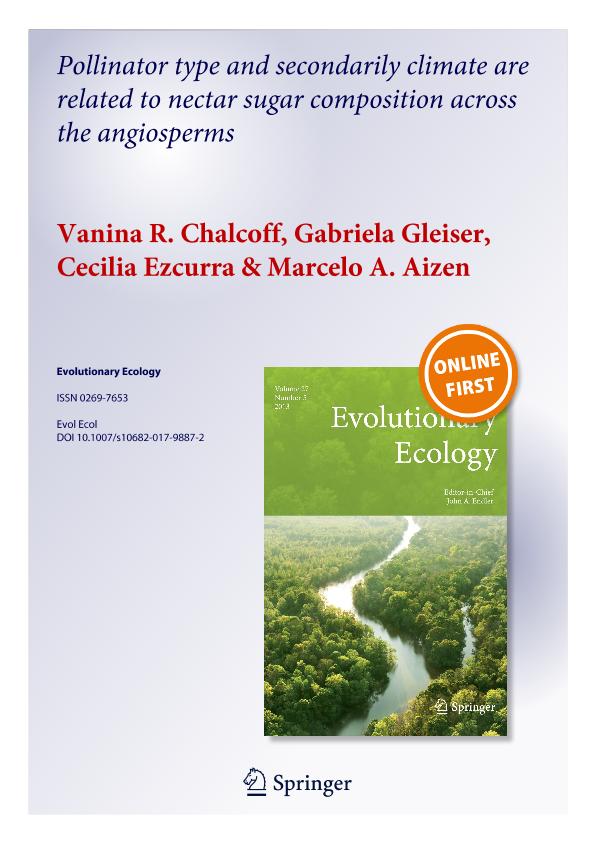Mostrar el registro sencillo del ítem
dc.contributor.author
Chalcoff, Vanina Ruth

dc.contributor.author
Gleiser, Gabriela Laura

dc.contributor.author
Ezcurra, Cecilia

dc.contributor.author
Aizen, Marcelo Adrian

dc.date.available
2018-11-16T17:48:37Z
dc.date.issued
2017-08
dc.identifier.citation
Chalcoff, Vanina Ruth; Gleiser, Gabriela Laura; Ezcurra, Cecilia; Aizen, Marcelo Adrian; Pollinator type and secondarily climate are related to nectar sugar composition across the angiosperms; Springer; Evolutionary Ecology; 31; 4; 8-2017; 585-602
dc.identifier.issn
0269-7653
dc.identifier.uri
http://hdl.handle.net/11336/64627
dc.description.abstract
Pollinators are important agents of selection on floral traits, including nectar sugar composition. Although it is widely assumed that the proportion of sugars (mainly sucrose, glucose and fructose) in nectar reflects pollinators’ physiological limitations and digestive efficiency, the relative impact of pollinators and abiotic factors on nectar sugar composition, as well as the generality of these associations across the angiosperms, remain unknown. We compiled data on nectar sugar composition for >1000 plant species, along with information on flower visitors, plant growth form and latitudinal climatic zone, to provide the first comprehensive assessment of correlates of variation in sugar nectar composition in the angiosperms. After assembling a phylogeny linking all species in the dataset, we estimated the amount of phylogenetic signal in the percentage of sucrose and, by applying phylogenetically-informed multiple regressions, we evaluated whether nectar composition was influenced either by the main pollinator group, plant growth form, or latitudinal climatic zone. The relative importance of each of these factors was then assessed through model selection based on Akaike information criteria and deviance partitioning analysis. Nectar was dominated by sucrose in 56.8% of all the species, glucose in 16.7%, and fructose in 5.5%. Nectar in the remaining species was characterized by similar proportions of the three sugars. Variation in the proportion of sucrose was highest (~70%) at the intrafamily level, and had a significant but low phylogenetic signal, which partially reflects phylogenetic conservatism of the pollinator niche. After controlling for phylogenetic effects, the proportion of sucrose was mainly related to pollinator type and secondarily to climate. Accordingly, this study indicates that nectar sugar composition shows high evolutionary lability and its variation reflects plant-pollinator associations.
dc.format
application/pdf
dc.language.iso
eng
dc.publisher
Springer

dc.rights
info:eu-repo/semantics/openAccess
dc.rights.uri
https://creativecommons.org/licenses/by-nc-sa/2.5/ar/
dc.subject
Comparative Analysis
dc.subject
Growth Form
dc.subject
Latitudinal Climatic Zone
dc.subject
Phylogenetic Signal
dc.subject
Pollinators
dc.subject
Sucrose
dc.subject.classification
Otras Ciencias Biológicas

dc.subject.classification
Ciencias Biológicas

dc.subject.classification
CIENCIAS NATURALES Y EXACTAS

dc.title
Pollinator type and secondarily climate are related to nectar sugar composition across the angiosperms
dc.type
info:eu-repo/semantics/article
dc.type
info:ar-repo/semantics/artículo
dc.type
info:eu-repo/semantics/publishedVersion
dc.date.updated
2018-10-23T16:17:59Z
dc.identifier.eissn
1573-8477
dc.journal.volume
31
dc.journal.number
4
dc.journal.pagination
585-602
dc.journal.pais
Alemania

dc.journal.ciudad
Berlin
dc.description.fil
Fil: Chalcoff, Vanina Ruth. Consejo Nacional de Investigaciones Científicas y Técnicas. Centro Científico Tecnológico Conicet - Patagonia Norte. Instituto de Investigaciones en Biodiversidad y Medioambiente. Universidad Nacional del Comahue. Centro Regional Universidad Bariloche. Instituto de Investigaciones en Biodiversidad y Medioambiente; Argentina
dc.description.fil
Fil: Gleiser, Gabriela Laura. Consejo Nacional de Investigaciones Científicas y Técnicas. Centro Científico Tecnológico Conicet - Patagonia Norte. Instituto de Investigaciones en Biodiversidad y Medioambiente. Universidad Nacional del Comahue. Centro Regional Universidad Bariloche. Instituto de Investigaciones en Biodiversidad y Medioambiente; Argentina
dc.description.fil
Fil: Ezcurra, Cecilia. Consejo Nacional de Investigaciones Científicas y Técnicas. Centro Científico Tecnológico Conicet - Patagonia Norte. Instituto de Investigaciones en Biodiversidad y Medioambiente. Universidad Nacional del Comahue. Centro Regional Universidad Bariloche. Instituto de Investigaciones en Biodiversidad y Medioambiente; Argentina
dc.description.fil
Fil: Aizen, Marcelo Adrian. Consejo Nacional de Investigaciones Científicas y Técnicas. Centro Científico Tecnológico Conicet - Patagonia Norte. Instituto de Investigaciones en Biodiversidad y Medioambiente. Universidad Nacional del Comahue. Centro Regional Universidad Bariloche. Instituto de Investigaciones en Biodiversidad y Medioambiente; Argentina
dc.journal.title
Evolutionary Ecology

dc.relation.alternativeid
info:eu-repo/semantics/altIdentifier/doi/https://dx.doi.org/10.1007/s10682-017-9887-2
dc.relation.alternativeid
info:eu-repo/semantics/altIdentifier/url/https://link.springer.com/article/10.1007/s10682-017-9887-2
Archivos asociados
